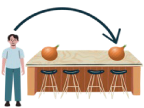

Home / Lessons / Level 2 / 4. Questions and Commands
In this module, you will learn how to ask questions about your surroundings and inquire about things from others. You will also see how to form an interrogative sentence.
Question: Wen wot ?  / Who is this?
/ Who is this?
Answers: Piyel.  / Peter.
/ Peter.
Tan kal.  / I don’t know.
/ I don’t know.
Question: Keq yut ?  / What is this?
/ What is this?
Answers: Pocetes.  / Potato.
/ Potato.
Nisonul wapeyikil wawonol.  / Two white eggs.
/ Two white eggs.
Tan kal.  / I don’t know.
/ I don’t know.
To ask for something from another person, you need to use particles that specify where the object is located, depending on whether it is animate or inanimate.
| - Key Notion - | |||
|---|---|---|---|
| Animate | Inanimate | ||
Not  This (close to) |
Milin not opan.  / Give me this bread. / Give me this bread.Npawala not lakalet.  / I want this bread. / I want this bread. |
Nit  This |
Milin nit kahpe.  / Give me this coffee. / Give me this coffee.Npawatomon nit ti.  / I want this tea. / I want this tea. |
Yat  That (far) |
Milin yat cikon.  / Give me that apple. / Give me that apple.Npawala yat minsoss.  / I want that raspberry. (singular form) / I want that raspberry. (singular form)Npawalak yehkt not minsossok.  / I want these raspberries. (plural form) / I want these raspberries. (plural form) |
Yet  That (far) |
Milin yet wawon.  / Give me that egg. / Give me that egg.Npawatomon yet alincis.  / I want that orange. / I want that orange. |
Yut*  (here) |
* | Wot*  (here) |
* |
| * We don’t use the particles ‘yut’ and ‘wot’ to ask for something, because they mean that we already have them with us (here). | |||
To ask questions, it’s not always necessary to form sentences. In many cases, simply adding a question mark can transform an affirmative verb into a question. In this case, just remember to use «kil-(k)» to indicate who the question is directed to.
Examples:
Affirmative form (I): Npawatomon kahpe.  / I want coffee.
/ I want coffee.
Interrogative form (I): Kpawatomon kahpe ?  / Do you want coffee?
/ Do you want coffee?
Affirmative form (A): Npawala lakalet.  / I want frybread.
/ I want frybread.
Interrogative form: Kpawala lakalet ?  / Do you want frybread?
/ Do you want frybread?
Affirmative form: Nkospon.  / I am tired.
/ I am tired.
Interrogative form: ‘Kospon ?  / Are you tired?
/ Are you tired?
Affirmative form: Nkotuhp.  / I’m hungry.
/ I’m hungry.
Interrogative form: ‘Kotuhp ?  / Are you hungry?
/ Are you hungry?
Affirmative form: Nmacaha.  / I’m going back home.
/ I’m going back home.
Interrogative form: Kmacaha ?  / Are you going back home?
/ Are you going back home?
Piyel wants to have the thing he points to. How can he express this correctly depending on whether the thing is near or far from him?
Note: it is also necessary to distinguish between what is animate and inanimate.
 Give me this bannock.
Give me this bannock. Give me that bannock.
Give me that bannock. Give me this egg.
Give me this egg. Give me that orange.
Give me that orange. Give me this orange.
Give me this orange.Piyel wants to have the thing he points to. How can he express this correctly depending on whether the thing is near or far from him?
Note: it is also necessary to distinguish between what is animate and inanimate.
 I want that onion.
I want that onion. I want this egg.
I want this egg. I want this onion.
I want this onion. I want this bannock.
I want this bannock. I want this orange.
I want this orange.Transform the negative sentences into affirmative sentences.
| 1. | I do not live in St. Mary’s. |
| 2. | Moose meat is not red. |
| 3. | I do not want to eat four apples. |
| 4. | The juice is not yellow. |
Additional information for exercises solutions may appear in the Appendix of the PDF document.